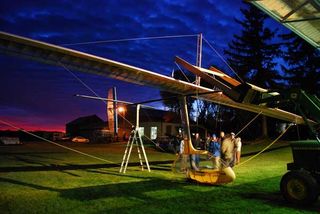Human-Powered Aircraft Flaps Wings in Flying First

Humanity spent centuries trying to fly like birds with flapping wings before finally developing the technologies needed to soar with balloons and then taking to the air with gas-powered, fixed-wing aircraft.
Now, as if flying full circle, a human-powered aircraft that flies using flapping wings has been invented.
The Snowbird is the first human-powered ornithopter — an aircraft that flies by flapping its wings — to fly continuously. During its record-setting flight on Aug. 2, it maintained both altitude and airspeed for 19.3 seconds, covering a distance of 475 feet (145 meters) at an average speed of 15.9 mph (25.6 kph). [Video - Watch Snowbird Flap Its Wings]
"The Snowbird represents the completion of an age-old aeronautical dream," said aerospace engineering doctoral student Todd Reichert of the University of Toronto, who powered and piloted the Snowbird and was its lead developer. "Throughout history, countless men and women have dreamt of flying like a bird under their own power, and hundreds, if not thousands have attempted to achieve it. This represents one of the last of the aviation firsts."
For centuries, engineers have attempted to make the myth of Icarus real, with Leonardo da Vinci sketching the first human-powered ornithopter in 1485. The problem with such flight until now was that it was too hard to generate enough lift to fly.
How it works
Remarkably, although the Snowbird has a wingspan of 105 feet (32 meters), comparable to that of a Boeing 737, it weighs just 94 pounds (42.6 kilograms), less than all of the pillows onboard a typical Boeing 737.
Sign up for the Live Science daily newsletter now
Get the world’s most fascinating discoveries delivered straight to your inbox.
"The primary structure is made of carbon fiber tubes we made ourselves, with exactly the right stiffness and strength needed," Reichert said. The rest "is just foam and balsa wood and basswood, like you'd make a small model aircraft out of."
This combination of wingspan and light weight is crucial.
"It's such a cool engineering challenge," Reichert said. "Nothing is extra — everything is cut down to the bare minimum."
It also helped that Reichert lost 18 pounds (8.1 kh) of body weight before the flight.
"First I got hooked up with a coach who used to be on the national kickboxing team," Reichert said. "He knew how to build strength without gaining weight, and almost doubled how much I could push without building mass. In the last phase, with about a month to go, I started losing weight, really eating a lot of vegetables and lean protein like chicken. I wasn't starving myself — I was eating a large amount of food to keep my strength up — but it's not something you can sustain for the long-term, and a week after the flight, I gained all the weight back."
About that name
The Snowbird got its name last year in late October, when the researchers were testing it on the runway. "The runway was full of snow, and as we were dragging the cockpit along the ground, it filled with snow," Reichert recalled.
Reichert and his colleagues made their history-making flight at the Great Lakes Gliding Club in Tottenham, north of Toronto, at about 6:45 in the morning. "We wanted to fly when there were absolutely zero winds, so at sunrise or sunset," he explained. "We got up at 4 or 5 and started assembling the aircraft — it's too big to fit in any barn or hanger we had access to. It comes apart in four pieces."
The ornithopter was towed down a grass strip runway by a car and then released.
"We maintained speed and altitude to prove that we were flying and not gliding," Reichert said.
Reichert powered the Snowbird with his legs, "which have the strongest muscles in your body. I just pushed both legs down together simultaneously, as if in a gym doing a leg press, and every time I pushed, a wire connected to the wings pulled them down."
He estimated that he generated between 600 and 700 Watts of power, with 700 to 800 pounds of force on each stroke.
To land, "there was one small wheel, like a wheel from a baby stroller, and a skid in the front," Reichert said. "You land on the wheel, roll a bit, and then touch down on the skid. We actually started with two wheels in early flights, but then discovered you typically land on just one wheel, so we chopped off the second one. With this aircraft, when something isn't needed, you cut it off." [Gallery of Unique Aircraft]
Impractical inspiration
Although this aircraft is not a practical method of transport, it can "act as an inspiration to others to use the strength of their body and the creativity of their mind to follow their dreams," Reichert said. This research promotes how "human power, when walking or cycling, is an efficient, reliable, healthy and sustainable form of transportation."
"Although I don't see a particular application, you never know what people are going to be inspired by — when people climbed Everest, it inspired other people in what they were doing," Reichert told LiveScience. "It inspires people to think twice about what's possible."
The researchers filed their official record claim was filed in September. The Fédération Aéronautique Internationale (FAI), the world-governing body for air sports and aeronautical world records, is expected to confirm the ornithopter's world record at its meeting in October.
- Gallery: Defining Moments in Human Flight
- 10 Events That Changed History
- Leonardo Da Vinci’s 10 Best Ideas

Most Popular


